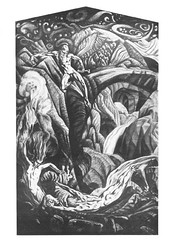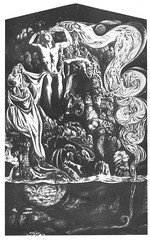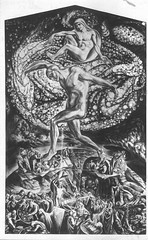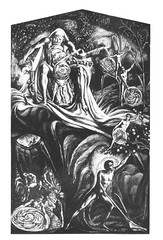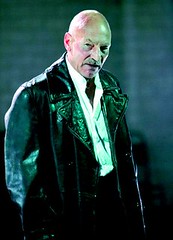 We took the opportunity of our theater trip to the borough of Brooklyn to visit their Polytechnic University, just a few blocks from BAM. Hanging in the lobby of their Dibner/CATT building - shown to the right - on permanent display are five murals by Mordi Gassner (1899-1995), perhaps the most amazing person I have ever met. The 6 by 9 foot murals - dating from the late 1920's/early 1930's - are his interpretation of the sciences of physics, geology, astronomy, chemistry and biology.
We took the opportunity of our theater trip to the borough of Brooklyn to visit their Polytechnic University, just a few blocks from BAM. Hanging in the lobby of their Dibner/CATT building - shown to the right - on permanent display are five murals by Mordi Gassner (1899-1995), perhaps the most amazing person I have ever met. The 6 by 9 foot murals - dating from the late 1920's/early 1930's - are his interpretation of the sciences of physics, geology, astronomy, chemistry and biology. The last time I saw the murals were in his home, a converted church near Drakes Branch, Virginia. I had been introduced to Mordi and his wife Marion by my then wife Paula. While one was immediately struck by the surrounding artwork and his stories of designing sets on films in the early days of Hollywood - and later Broadway and 1950's television, painting in Florence as a two-time Guggenheim Fellow, decorating post offices with murals for the WPA,
The last time I saw the murals were in his home, a converted church near Drakes Branch, Virginia. I had been introduced to Mordi and his wife Marion by my then wife Paula. While one was immediately struck by the surrounding artwork and his stories of designing sets on films in the early days of Hollywood - and later Broadway and 1950's television, painting in Florence as a two-time Guggenheim Fellow, decorating post offices with murals for the WPA,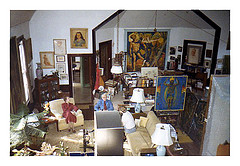 and making ends meet as a commercial artist, it became evident that he was more than an artist. He was a true renaissance man in the spirit of the age that inspired his humanism. Mostly self-educated, he wielded the widest intellectual brush imaginable but remained the most humane human I have ever known, even after some of his contemporaries appropriated the sciences he loved in the service of evil.
and making ends meet as a commercial artist, it became evident that he was more than an artist. He was a true renaissance man in the spirit of the age that inspired his humanism. Mostly self-educated, he wielded the widest intellectual brush imaginable but remained the most humane human I have ever known, even after some of his contemporaries appropriated the sciences he loved in the service of evil.I sat for hours in awe of his ability to take almost any topic of conversation to places I could barely follow. Once, in an attempt to establish some credibility with him I mentioned that his remarks sometimes reminded me of one of my favorite authors, Lewis Mumford. (I had recently read but surely did not entirely grasp Technics and Civilization (1934) and The Myth of the Machine: technics and human civilization (1967)) He replied, "Ah, Lewis. We lived near each other in Brooklyn and often took walks together." I about dissolved. He KNEW Lewis Munford! Of, course. I should have known; they had much in common.
I will always treasure the time I spent with him and his wife Marion - a fascinating person in her own right - and hope I absorbed at least something from our many conversations. Even if I did not, I expect my daughter's interest in photography springs at least in part from her experiences wandering around his studio, soaking it all in - as small children well do.
The New Yorker ran a short piece about the murals when they were donated to Brooklyn Polytechnic.
And here are thumbnails of the murals.

